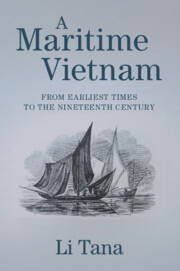Book contents
- A Maritime Vietnam
- Dedication
- A Maritime Vietnam
- Copyright page
- Contents
- Figures
- Maps
- Tables
- Preface
- Introduction
- 1 Maritime Formations
- 2 Aromatics, Buddhism, and the Making of a South Seas Emporium
- 3 ‘THE Harbour and THE Path of All Countries’
- 4 Maritime Resurgence and the Rise of Dai Viet
- 5 Winds of Trade from the Middle East
- 6 Muslim Trade and the Conquest of the Coast
- 7 Silks and Society
- 8 Seventeenth-Century Dang Trong
- 9 The Rise and Fall of the Eighteenth-Century Water Frontier
- 10 Ships and the Problem of Political Integration
- Conclusion
- Bibliography
- Index
7 - Silks and Society
Tongking in the Age of Commerce
Published online by Cambridge University Press: 12 January 2024
- A Maritime Vietnam
- Dedication
- A Maritime Vietnam
- Copyright page
- Contents
- Figures
- Maps
- Tables
- Preface
- Introduction
- 1 Maritime Formations
- 2 Aromatics, Buddhism, and the Making of a South Seas Emporium
- 3 ‘THE Harbour and THE Path of All Countries’
- 4 Maritime Resurgence and the Rise of Dai Viet
- 5 Winds of Trade from the Middle East
- 6 Muslim Trade and the Conquest of the Coast
- 7 Silks and Society
- 8 Seventeenth-Century Dang Trong
- 9 The Rise and Fall of the Eighteenth-Century Water Frontier
- 10 Ships and the Problem of Political Integration
- Conclusion
- Bibliography
- Index
Summary
The seventeenth century shaped Dai Viet in major ways. Like their counterpart in Cochinchina, the Le-Trinh regime directly involved in the silk for sliver trade. Eight tons of silver flew into Tongking bringing the wealth of the nation to a new level. Commerce changed culture in many ways, from the introduction of Christianity to the emergence of Lieu Hanh, a new religious figure connected to women traders. It modernised Tongking’s firearms and financed the seven campaigns against Cochinchina. It stimulated the import of Chinese books and prints, which had become more accessible and affordable to the literati class. Add to this new wealth in circulation more broadly, a construction boom, and increased participation of women. Like the thirteenth century, the Red River delta saw another political integration, this time between the military group from Thanh Hoa and the literati from the Red River delta. It may not be a coincidence that both eras s saw the extensive and intensive maritime commerce both in the country and with overseas. The synergy brought in by the maritime wealth however created a more systematically Confucianist institution from the village up. The autonomous village now became the fixed image of Vietnam.
Keywords
- Type
- Chapter
- Information
- A Maritime VietnamFrom Earliest Times to the Nineteenth Century, pp. 195 - 227Publisher: Cambridge University PressPrint publication year: 2024

